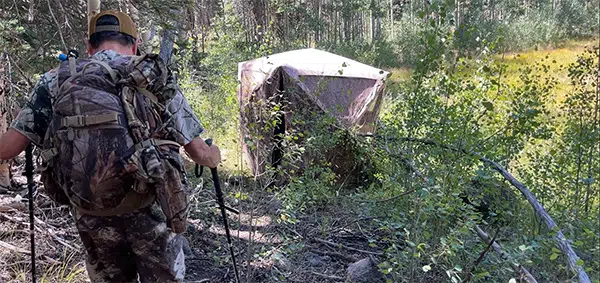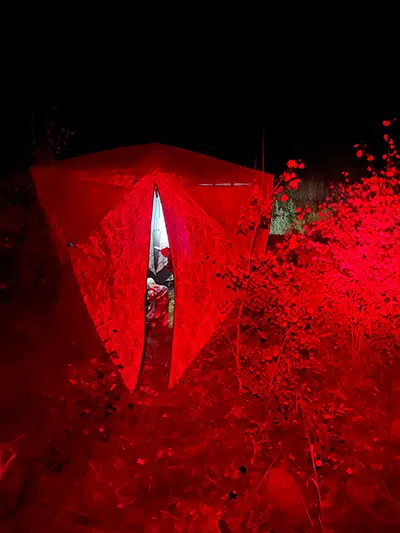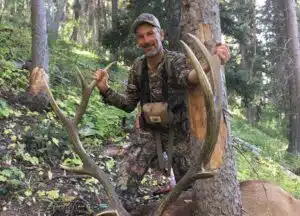
BY LEROY CHAVEZ
I never thought that I would ever hunt the majestic wapiti from a blind, but there I was during the 2021 Elk season overlooking a spring with several well-used wallows.

My rehabilitation from a bout with cancer and an impinged C10 vertebrae, in which I lost the ability to walk, is still a work in progress. I can walk, though robotic-like and sometimes unstable. Walking and hunting elk in the woods this past season would have been near impossible since I have to use two walking sticks (ski poles) and cannot carry my bow at the same time. That meant that the selection site for our first OTC Elk hunt in Colorado was a challenge, as the physical limitations of every camp crew member were taken into consideration.
Nonetheless, ElkBros veteran Joe Giglia decided on an area that would accommodate different levels of fitness, and of course, my physical limitations. Joe along with R.C. Knox and the Flatlander, Cole Wilks, came up with several viable options. They did a lot of e-scouting and made several trips to Colorado to put boots on the ground and look for signs. The work paid off and we had several promising OTC units to pick from.

It was our second camp option that proved to be the winner as virtually every hunter on every outing encountered elk. A wallow only 300 yards from an old two-track road was selected as a site for my blind. Walking in was not difficult, but the return trip was tough due to a steep decline. The blind proved to be fruitful as I was blessed to see multiple bulls and cows and even a shot opportunity on a small bull.
This article is about my observations from Elk hunting from a blind.
Using a blind can prolong being able to hunt elk when not being able to walk, or when any other debilitating injury, limits your mobility and options.
While in the blind, during my 8-day hunt, I made the following observations:
It reinforced what I knew about elk behavior. A bull, with or without cows, will visit a wallow or water hole during the mid-day hours when temperatures are soaring at their highest. I observed this during this hunt and at various times in past hunts.

Elk, in this case, were not overly cautious about the blind when entering the wallow and surrounding area. However, a small buck approached very cautiously and kept his eye on the blind for well over 5 to 10 minutes before watering.
A bobcat also appeared, drank some water, then playfully pranced around for about 10 minutes before leaving.
Scent did not seem to be an issue as elk approached the blind from all sides, with some cows traveling behind the blind. Something did spook a FEW FEET from the blind behind me. Whatever the “animal” was, it got close up and personal. I was never able to identify the startled animal. The blind kept my scent down to a minimum since I was in the blind for at least 3 to 4 hours before any animal arrived.
During my days in the blind, I had about 20 elk come into the wallow. Three bulls appeared on different days between 12:30 and 3:30, with two bulls accompanied by 3 to 4 cows. One bull came in solo and played in the wallow for about 15 minutes. Several small groups of cows and calves came in between the hours of 5:30 to 7:00.

I feel that bull elk are active at night eating, chasing cows, and battling other bulls. I’m sure they also water at night, but drinking may be an afterthought, especially during the rut. High temperatures, bothersome insects, and thirst will becken bulls to water as temperatures soar during the daytime. Mid-day to mid-afternoon is a good time to water and wallow in the mud to keep insects off.
Meanwhile, cows and calves will water as soon as the shadows lengthen and twilight approaches.

A lot of hunters are done with the “morning hunt” around 10:00 a.m. and head back to camp for lunch and rest. They then resume their afternoon hunt around 4ish. So most hunters are missing out on the middle-of-the-day period. That is when the bulls will head to the water and wallow unless they are already bedded close to water.
So my friends, if age, injury, or ill-timed mishaps hamper your ability to chase the majestic Wapiti in the mountains, perhaps hunting from a blind may be a solid option.



Coach Chavez,
Always the student, the coach and the teacher! Great observations . . . so glad to know you continue to recover.
I am inspired! I will continue to send prayers and good medicine.
-chico
Leroy, you are a man among boys my friend. Thanks for sharing your thoughts and perspectives with us. You my friend are the YODA of Elk Hunting. I’m so thankful that God allowed us to cross paths in this life.
Great insights Mr Chavez. Sometimes hurry up and wait pays off. The accounts sound fun and lively. I appreciate your notes, especially about time of day.
Great article, especially for handicap and older hunters. Hunting from a hide has always been my preferred method of rifle hunting. However, this only works if another hunter doesn’t walk through and blow out your area. Avoiding hunter activity in an area is the key to hunting from a hide. Water, grazing and bedding are the other critical factors in choosing to hunt from a hide. Public hunting pressure and weather conditions will drive elk and mule deer into one of three areas for escape: up high, foothills and grasslands, and private land. Hide hunting in one of these three areas can be fruitful!
I have been very successful on a wallow. However, I know that there are bulls within 200 yards of my blind at any one time. My son can hear them when he is a long. But I am hearing challenged and so its difficult to go after them. I am looking for options to help me with that and elkbros has gotten me into their Grinder call. Its so easy to use and Joe helped me with placement and its made a world of difference. I am looking forward to this September and calling in a bull instead of waiting for them to show. I have learned so much and its so appreciated. Buy the Grinder if you have not. It will change your game. kevin
Through the years, experience has taught me the wisdom of a cow’s mating call when the bulls are talking.
Coach Chavez,
I wrote a little letter on the Elkbros email so I wont bore you with details. I also had a health issue that slowed me down. I have four different wallows I have watched over the years. We didn’t use a pop up blind but my sons helped me make ground blinds with the dead fall and branches that were laying around. I was blessed to harvest a cow elk this year.
Thanks for being a inspiration to use all and your insight on hunting from a blind. My prayers are with you.
I was watching a episode of you talking about drawing. Many years ago when they first come out with gps units, I was up deer hunting and did some rattling. Waiting, nothing was happening so I turned and was playing with the gps for some reason. When I turned around, there was a nice 4point buck, so i slowly walked towards him and rattled. He just looked at me, then walked out to about 80 giving me one last look and finally walked on. I was in full view but he was focused on the sound like you said.